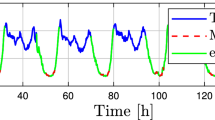Abstract
In recent years, there has been an increase in leak zone identification strategies in water distribution networks. This paper presents an analysis of the effect network partitioning techniques have on the performance of leak zone location methodologies. An SVM classifier is used to identify the leak zone location. The effect of the following clustering methods for network partitioning is analyzed: k-medoids, agglomerative clustering, DBSCAN, and Girvan-Newman algorithm. Both topological and hydraulic variables are considered when performing the clustering with three different sensor configurations. The results obtained demonstrate that the effect of each clustering method on the leak location performance is similar for both types of variables.
Access this chapter
Tax calculation will be finalised at checkout
Purchases are for personal use only
Similar content being viewed by others
References
Chartrand, G., Zhang, P.: A First Course in Graph Theory. Courier Corporation (2012)
Chen, J., Xin, F., Xiao, S.: An iterative method for leakage zone identification in water distribution networks based on machine learning. Struct. Health Monit. (2020). https://doi.org/10.1177/1475921720950470
Ester, M., Kriegel, H.P., Sander, J., Xu, X.: A density-based algorithm for discovering clusters in large spatial databases with noise. In: Proceedings of 2nd International Conference on Knowledge Discovery and Data Mining (1997)
Quiñones Grueiro, M., Verde, C., Llanes-Santiago, O.: Novel leak location approach in water distribution networks with zone clustering and classification. In: Carrasco-Ochoa, J.A., Martínez-Trinidad, J.F., Olvera-López, J.A., Salas, J. (eds.) Pattern Recogn., pp. 37–46. Springer International Publishing, Cham (2019)
Hollander, M., Wolfe, D.A., Chicken, E.: Nonparametric statistical methods. John Wiley & Sons, 2nd Edition (2013)
Jennings, P.C., Lysgaard, S., Hummelshoj, J.S., Vegge, T., Bligaard, T.: Genetic algorithms for computational materials discovery accelerated by machine learning. NPJ Computational Materials 5(46) (2019)
Jung, Y., Park, H., Du, D.Z., Drake, B.L.: A decision criterion for the optimal number of clusters in hierarchical clustering. J. Global Optim. 25(1), 91–111 (2002)
Kang, J., Park, Y.J., Lee, J., Wang, S.H.: Novel leakage detection by ensemble CNN-SVM and graph-based localization in water distribution systems. IEEE Trans. Ind. Electron. 65(5), 4279–4289 (2017)
Kaufman, L., Rousseeuw, P.J.: Finding Groups in Data. An Introduction to Cluster Analysis. John Wiley & Sons (2005)
Kaufman, L., Rousseeuw, P.J.: Clustering by means of medoids. In: Statistical Data Analysis Based on the L1-Norm Conference, pp. 405–416. Elsevier Science, Neuchatel (1987)
Montgomery, D.C.: Design and Analysis of Experiments. John Wiley & Sons, 8th Edition (2013)
Newman, M.E.J., Girvan, M.: Finding and evaluating community structure in networks. Phys. Rev. E 69, 026113 (2004)
Rheman, S.U., Khan, K., Aziz, K., Fong, S., Sarasvady, S.: Dbscan: Past, present and future. In: 2014 Fifth International Conference on the Applications of Digital Information and Web Technologies (ICADIWT 2014) (2014)
Rossman, L.A.: Epanet 2 Users Manual (2000)
Sanz, G., Meseguer, J., Pérez, R.: Model calibration for leak localization, a real application. In: CCWI 2017: 15th Computing and Control for the Water Industry Conference 2017, pp. 1–9. Sheffield (UK) (September 2017)
Shekofteh, M., Jalili-Ghazizadeh, M., Yazdi, J.: A methodology for leak detection in water distribution networks using graph theory and artificial neural network. Urban Water J. 17(6), 525–533 (2020)
Soldevila, A., Fernández-canti, R., Blesa, J., Tornil-sin, S., Puig, V.: Leak localization in water distribution networks using bayesian classifiers. J. Process Control 55, 1–9 (2017)
Sun, C., Parellada, B., Puig, V., Cembrano, G.: Leak localization in water distribution networks using pressure and data-driven classifier approach. Water 12, 54 (2020)
Wang, Q., Guidolin, M., Savic, D., Kapelan, Z.: Two-objective design of benchmark problems of a water distribution system via MOEAs : towards the best-known approximation of the true pareto front. J. Water Resour. Plan. Manage. 141(3), 1–14 (2015)
Zhang, Q., Wu, Z.Y., Zhao, M., Qi, J.: Leakage zone identification in large-scale water distribution systems using multiclass support vector machines. J. Water Resour. Plan. Manage. 142(11), 04016042 (2016)
Author information
Authors and Affiliations
Editor information
Editors and Affiliations
Rights and permissions
Copyright information
© 2021 Springer Nature Switzerland AG
About this paper
Cite this paper
Ares-Milián, M.J., Quiñones-Grueiro, M., Corona, C.C., Llanes-Santiago, O. (2021). Clustering-Based Partitioning of Water Distribution Networks for Leak Zone Location. In: Tavares, J.M.R.S., Papa, J.P., González Hidalgo, M. (eds) Progress in Pattern Recognition, Image Analysis, Computer Vision, and Applications. CIARP 2021. Lecture Notes in Computer Science(), vol 12702. Springer, Cham. https://doi.org/10.1007/978-3-030-93420-0_32
Download citation
DOI: https://doi.org/10.1007/978-3-030-93420-0_32
Published:
Publisher Name: Springer, Cham
Print ISBN: 978-3-030-93419-4
Online ISBN: 978-3-030-93420-0
eBook Packages: Computer ScienceComputer Science (R0)





